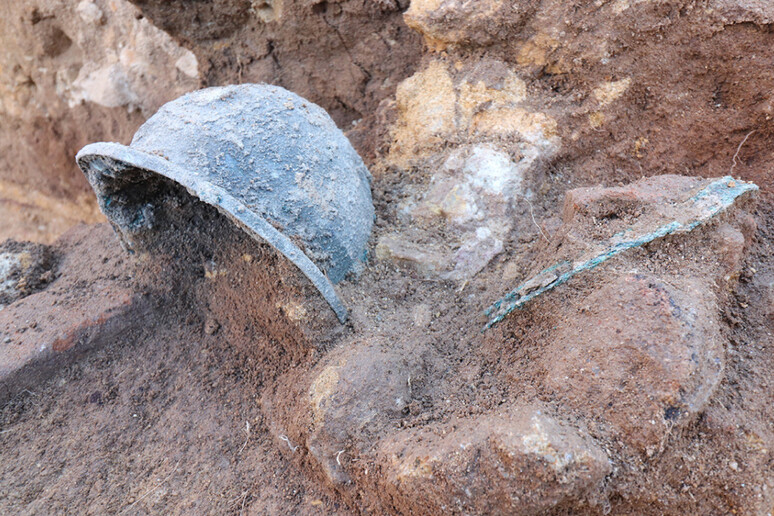(By Silvia Lambertucci).
It was 540 BC when, off the coast of Corsica, in what the ancients called the sea of Sardinia, the first great naval battle of history took place.
An epic and bloody struggle described by Herodotus and which saw the powerful Phoecians, Greek colonists who had settled in the Corsican city of Alalia, come under the joint attack of Etruscans and Carthaginians.
In the clash, the partisan Herodotus maintains, the Greeks had the better of it.
But the ships which had managed to save themselves were no longer able to fight, and had to take on board families, abandon Alalia and set sail for southern Italy, where, skillful traders that they were, they bought a piece of land and founded Hyele, which was later renamed Elea, or Velia for the Romans, the Magna Graecia city where the philosopher Parmenides was born.
And it is in this very place, as director-general of Italian museums Massimo Osanna has revealed to ANSA in an exclusive, that an excavation by archaeologists in the Archaeological Park of Paestum-Velia has brought to light weapons which in all probability came from that very epoch-making battle.
It is a discovery, the expert says, "that sheds fresh light on this fascinating chapter in ancient history".
Culture Minister Dario Franceschini also hailed the find, stressing the importance of "continuing to invest with conviction in archaeological research that keeps yielding major pieces of the history of the Mediterranean".
Starting last summer on the tip of what was the city's acropolis, right underneath the remains that are still visible today of the Temple of Athena, the dig led by Francesco Scelza unearthed the remains of a rectangular structure of notable size, 18 metres long by seven wide, dating back to the sixth century BC.
On the inside, on a beaten clay floor, they found painted ceramics all marked with the word Ire ("holy"), evidence of the dedication to the goddess, as well as decorative architectural elements in baked clay that proved to have been created by craftsmen from Cumae, which was perhaps one of the leading Greek cities in the naval fight against the Etruscans, as well as some fragments of the ancient roof.
But that was not all.
Alongside the pottery, the temple floor also contained several bronze and iron weapons.
There are, Scelza says, many fragments of weapons, including what appear to be pieces of a large decorated shield and two splendid helmets in a perfect state of preservation: one Etruscan of the "shell" type, which experts call Negau from the Slovenian location where they were found for the first time, and the other of the Chalcidian type.
That is, in fact, the biggest surprise: "They are reliquaries offered to Athena, with all probability the very spoils from the Battle of Alalia," says Osanna, who pending the installation of the new site director, Tiziana D'Angelo, has taken on the running of the Park over the last year.
These are, of course, only preliminary considerations. Freed from the earth only a few days ago, the two helmets must now be cleaned in the laboratory and studied. There may be inscriptions inside them, something quite common in ancient armour, and any inscriptions could help reconstruct with precision their history and, who knows, also perhaps the identity of the warriors who wore them.
But already in its present state the discovery of the ancient temple with its date and the objects kept inside it clears up many details of that story dating back more than 2,500 years.
"The structure of the oldest temple dates back to 540-530 BC, or the very years following the battle of Alalia," Osanna points out.
While that of the more recent temple, which was thought to be of Hellenistic origin, goes back to 480-450 BC, to be restructured in the fourth century BC.
It is possible, therefore, that the Phoecians who fled Alalia built it immediately after their arrival in this stretch of coastline - today identified between Punta Licosa and Palinuro in the province of Salerno - where, as was their custom and how Herodotus tells us once again, they traded with the native Oenotrians and bought the land necessary to settle and resume the rich trade they were famous for.
It is almost certain that the foundation of the temple in this process was to be considered of crucial importance for the success of the new settlement and that the memory of the bloody battle was still very fresh, so much so that they decided to offer the goddess, in order to propitiate her benevolence, the weapons they had stripped from their Etruscan enemies in that epic clash on the sea which in fact changed the balance of power in the Mediterranean.
Something similar was to happen one century later, in 474 BC, with the Battle of Cumae. And if at Alalia the Greeks were eventually forced to flee, at Cumae it would be the Etruscans who would give way, dragging down into the pit of history also nearby Pompeii, for a long spell of time. But that is another story.
ALL RIGHTS RESERVED © Copyright ANSA











